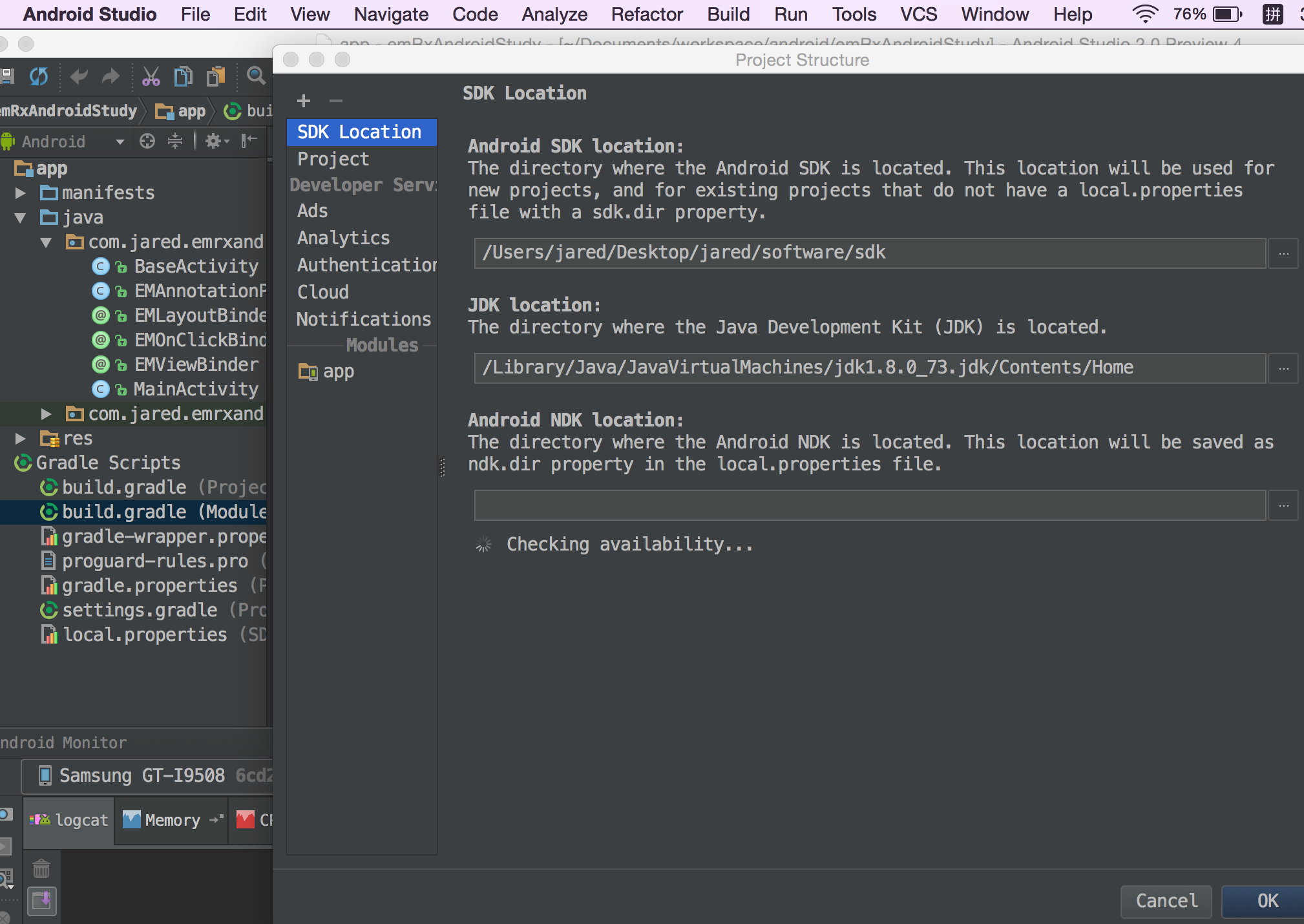RxJava的简单使用基本上也了解了,其实还有一个比较好玩的就是java8才有的lambda了。
lambda在android studio下的环境搭建
下载java8
下面就来搭建下这个环境了,因为android不支持java8,所以需要用到一个开源库, retolambda,点这里。具体怎么使用基本上都有,这里简单地介绍下,首先就是下载java8了:下载java8,点这里。
修改配置工程文件
下载好安装好后,需要修改build.gradle:
// Top-level build file where you can add configuration options common to all sub-projects/modules.
buildscript {
repositories {
jcenter()
}
dependencies {
classpath 'com.android.tools.build:gradle:1.5.0'
classpath 'me.tatarka:gradle-retrolambda:3.2.0'
// NOTE: Do not place your application dependencies here; they belong
// in the individual module build.gradle files
}
}
allprojects {
repositories {
jcenter()
}
}
task clean(type: Delete) {
delete rootProject.buildDir
}
这里添加了me.tatarka:gradle-retrolambda:3.2.0。
接着是 app目录下的build.gradle:
apply plugin: 'com.android.application'
apply plugin: 'me.tatarka.retrolambda'
android {
compileSdkVersion 23
buildToolsVersion "23.0.2"
defaultConfig {
applicationId "com.jared.emrxandroidstudy"
minSdkVersion 15
targetSdkVersion 23
versionCode 1
versionName "1.0"
}
buildTypes {
release {
minifyEnabled false
proguardFiles getDefaultProguardFile('proguard-android.txt'), 'proguard-rules.pro'
}
}
compileOptions {
sourceCompatibility JavaVersion.VERSION_1_8
targetCompatibility JavaVersion.VERSION_1_8
}
}
dependencies {
compile fileTree(dir: 'libs', include: ['*.jar'])
testCompile 'junit:junit:4.12'
compile 'com.android.support:appcompat-v7:23.1.1'
compile 'io.reactivex:rxandroid:1.1.0'
compile 'io.reactivex:rxjava:1.1.0'
}
修改工程的jdk版本
添加完后需要修改编译的jdk为java8:

lambda在RxAndroid中简单使用
修改完后,重新启动下工程,然后我们开始基于上一篇的文章继续了。这里对上一篇文章的代码通过lambda简化:
private void createObservableByMap() {
Log.d(TAG, "createObservableByMap");
Observable.just(getHello()).map(new Func1<String, String>() {
@Override
public String call(String s) {
return s + " by eastmoon";
}
}).subscribe(onNextAction);
}
onNextAction = new Action1<String>() {
@Override
public void call(String s) {
mHello.setText(s);
}
};简化后如下所示:
private void createObservableBylambda() {
Log.d(TAG, "createObservableBylambda");
Observable.just(getHello())
.map(s -> s + " by eastmoon")
.subscribe(s -> mHello.setText(s));
}是不是非常清晰,非常的简洁优雅,这里先不分析。
lambda表达式简介
lambda简单介绍及例子
简单理解下lambda吧,lambda是一种匿名表达式,关于lambda表达式这篇文章讲得不错:讲lambda比较好的文章。这里还是记录下当作学习吧,首先lambda的表达式一般是:
(argument) -> (body)其中argument表示参数,body表示函数体要做的事。常用的表达式如下:
(arg1, arg2...) -> { body }
(type1 arg1, type2 arg2...) -> { body }具体一些是这样:
(int a, int b) -> { return a + b; }
() -> System.out.println("Hello World");
(String s) -> { System.out.println(s); }
() -> 42
a -> a + 5
() -> { return 3.1415 };函数式接口简单介绍
通过上述例子,基本上也理解了表达式怎么用了。那么什么情况下可以使用lambda表达式呢?这里有个函数式接口的概念,函数式接口就是指只包含一个抽象方法声明的接口。Runnable只有一个接口run,所以它可以用lambda表达式实现。普通的方式如下:
Runnable r1 = new Runnable() {
@Override
public void run() {
Log.d(TAG, "testlambda");
}
};使用lambda表达式如下:
Runnable r2 = () -> Log.d(TAG, "testlambda");从六行代码搞到了一行代码,是不是超级简洁优雅。来个例子试试水吧:
private void testlambda() {
new Thread(new Runnable() {
@Override
public void run() {
Log.d(TAG, "test by normal func");
}
}).start();
new Thread(() -> Log.d(TAG, "test by lambda func")).start();
}这里通过创建线程在run方法中输出信息,可以看出两种效果一模一样:
03-11 09:18:39.453 27601-28067/? D/MainActivity: test by lambda func
03-11 09:18:39.453 27601-28066/? D/MainActivity: test by normal func函数式接口地简单实现
既然需要函数式接口,那么我们来简单的实现下函数式接口,新建FunctionLambda接口:
package com.jared.emrxandroidstudy;
/**
* Created by jared on 16/3/11.
*/
public interface FunctionLambda {
public void hello();
}接着编写类FunctionLambdaTest:
package com.jared.emrxandroidstudy;
/**
* Created by jared on 16/3/11.
*/
public class FunctionLambdaTest {
public static void helloTest(FunctionLambda functionLambda) {
functionLambda.hello();
}
}接着我们来实现下这个功能:
private void testFunctionLambda() {
FunctionLambdaTest.helloTest(new FunctionLambda() {
@Override
public void hello() {
Log.d(TAG, "test by normal testFunctionLambda");
}
});
FunctionLambdaTest.helloTest(() -> Log.d(TAG, "test by lambda testFunctionLambda"));
}
输出信息如下:
03-11 09:30:29.005 28776-28776/? D/MainActivity: test by normal testFunctionLambda
03-11 09:30:29.005 28776-28776/? D/MainActivity: test by lambda testFunctionLambda效果一模一样,代码精简的不要不要的。
lambda在RxAndroid中的使用分析
好了,讲了这么多lambda表达式,还是看看rxAndroid用到的那个例子吧。这里再添下代码:
private void createObservableBylambda() {
Log.d(TAG, "createObservableBylambda");
Observable.just(getHello())
.map(s -> s + " by eastmoon")
.subscribe(s -> mHello.setText(s));
} 首先是map方法,因为map方法中重写了call方法,传入的参数为s,函数体里面要做的事情是s+” by eastmoon”,所以就写成了s -> s+” by eastmoon”,由这可知就是s变为了s+” by eastmoon”。同理subscribe方法也一样,传入的需要处理的mHello.setText(s)。
基本上lambda的简单使用ok了,接下去继续学习RxAndroid了。























 1127
1127











 被折叠的 条评论
为什么被折叠?
被折叠的 条评论
为什么被折叠?








